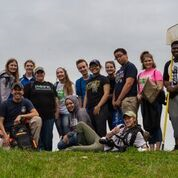The Philadelphia ZooCREW is an “immersive, award-winning urban youth program” organized by the Philadelphia Zoo. The goal behind the program is that participants will become conservation ambassadors through exposure to wildlife and the wildlife science field.
The Philadelphia ZooCREW is an "immersive, award-winning urban youth program" organized by the Philadelphia Zoo. The goal behind the program is that participants will become conservation ambassadors through exposure to wildlife and the wildlife science field. In 2014, with my then-adviser, Dr. Marcella Kelly, I planned and co-led an excursion to Blacksburg, Virginia for the ZooCREW. The ZooCREW participants spent one day at a biological station learning how to sample amphibians and reptile communities using cover boards and how to set up camera traps, and another day learning how to use ArcGIS, measuring bear cub paws, and talking with current graduate students about their research and the Virginia Tech wildlife program. The program was written up by the College of Natural Resources (http://cnre.vt.edu/magazine/articles/college-news/201411/philadelphia-zoo- crew-kids- get-down- and-dirty.html).
This Memorial Day weekend (May 27th--May 28th), I led a similar excursion here in State College. The first day, we took the twelve sophomores and juniors to Shaver's Creek. There, we walked along the trails, learning about edible wild plants, why millipede poop smells like cherry candy, and hellbenders. The kids flipped stream rocks and logs to look for salamanders and we ended up with two long-tailed salamanders, a slimy salamander, and a crayfish. They learned about the importance of interstitial space between rocks and water quality for prime hellbender habitat.
Later that morning we walked to the nearby lake and looked along the bank and rocky areas for water snakes. We found tadpoles instead. Courtney Davis and David Muñoz told them about their research on amphibians and birds.
After a lunch at Irvings and a walk through downtown State College, the kids went back out to the public area around Coyler Lake. There, they were taught how to set up camera traps (i.e., cameras that are activated by movement/heat and take pictures of wildlife). After two practice sites in the public area, we went into Rothrock State Forest and set up three cameras. By this time, the kids were able to set up the cameras on their own, and one (Eric Stout) even navigated to a site using a GPS unit. While they were being taught to set up cameras, they were told how researchers might use camera traps to examine the composition of ecological communities, count animals, and examine habitat use.
On Sunday, as the weather wasn't very cooperative for outside activities, all activities were indoors. For two hours they skyped with eight scientists of all different study topics (e.g., salamander habitat, insect calls, and human-wildlife conflict between people and rattlesnakes), genders, and ethnicities. They learned about white nose disease, the benefit of social media in the lives of scientists, and above all, that there were much more that was still unknown in ecology than was known. After skyping and shortly after lunch, David Muñoz presented on how important it was to mark salamanders to estimate their abundance, and they carefully practiced marking with florescent elastomer on red grapes. After this, they left the Forest Resources Building and had a short campus tour that ended in South Frear, where they learned about the effect of climate change on stress and reproduction in fence lizards, a project that is run by Kirsty MacLeod.
This program was highly successful. One of the participants claimed it was the best of many of the field trips they had been on because it was largely hands-on, and two of the kids were later connected with scientists who were in fields that they would be interested in entering once they were undergraduates. Ultimately, the program coordinator, Laura Houston, was very clear that they would be interested in continuing this program annually at State College.
Story by Asia Murphy, PhD Ecology Candidate


